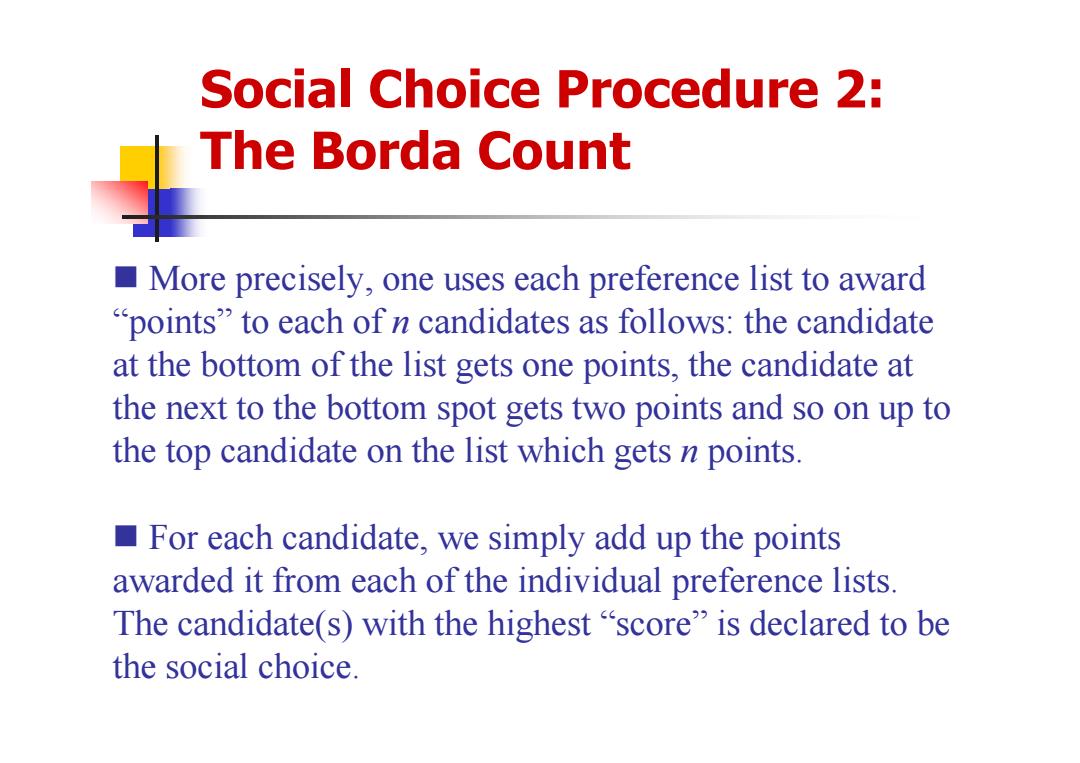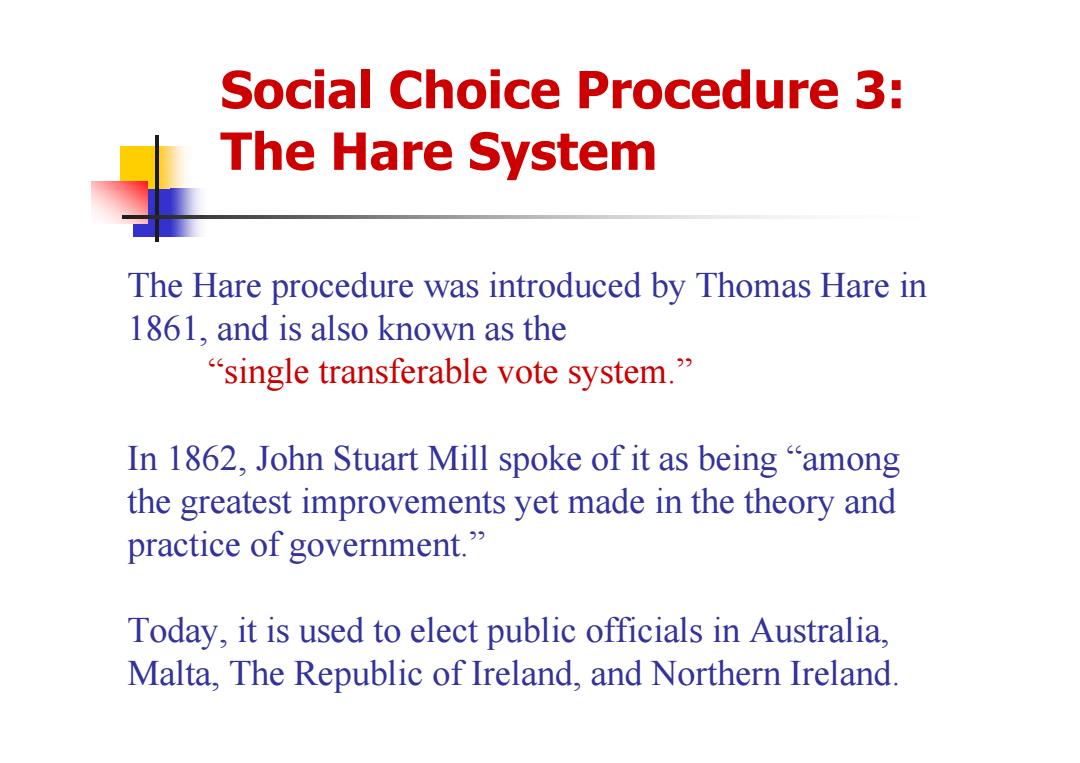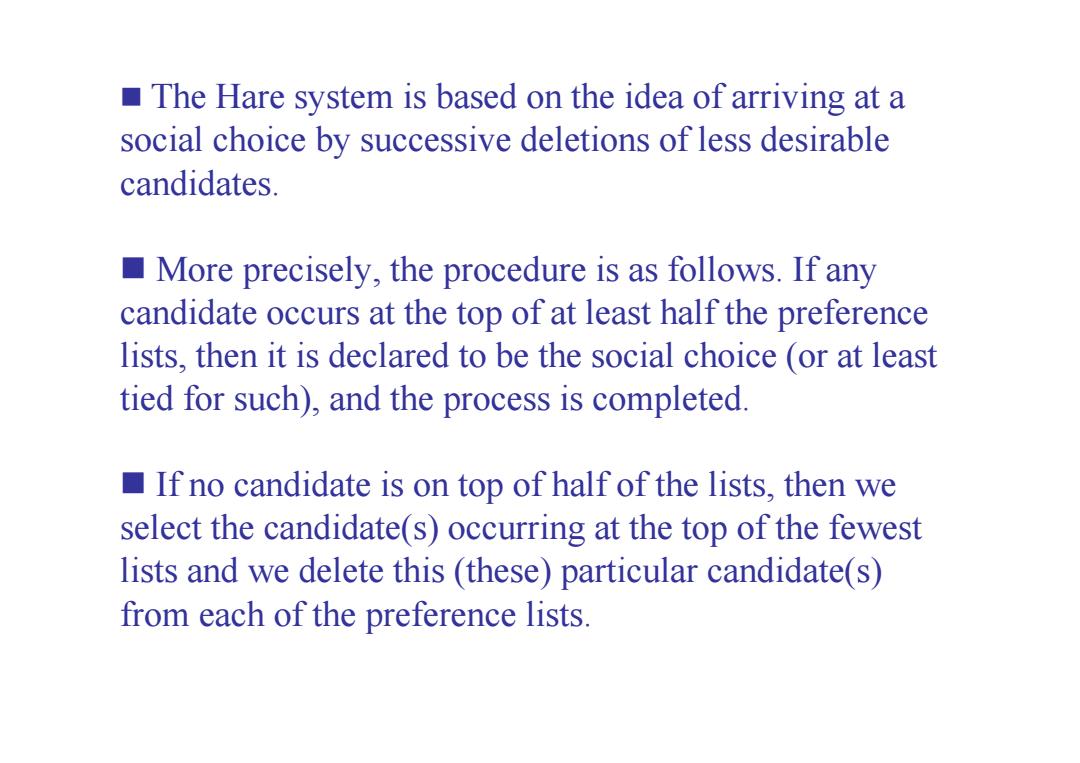
Social Choice Procedure 2: The Borda Count First introduced by Jean-Charles de Borda in 1781,the social choice procedure known as the Borda count. It is popular in situations where one really wants to take advantage of the information regarding individual intensity of preference provided by looking at how high up in an individual's preference list of a given candidate occurs
Social Choice Procedure 2: The Borda Count First introduced by Jean-Charles de Borda in 1781, the social choice procedure known as the Borda count. It is popular in situations where one really wants to take advantage of the information regarding individual intensity of preference provided by looking at how high up in an individual’s preference list of a given candidate occurs

Social Choice Procedure 2: The Borda Count More precisely,one uses each preference list to award "points"to each of n candidates as follows:the candidate at the bottom of the list gets one points,the candidate at the next to the bottom spot gets two points and so on up to the top candidate on the list which gets n points. For each candidate,we simply add up the points awarded it from each of the individual preference lists. The candidate(s)with the highest"score"is declared to be the social choice
Social Choice Procedure 2: The Borda Count More precisely, one uses each preference list to award “points” to each of n candidates as follows: the candidate at the bottom of the list gets one points, the candidate at the next to the bottom spot gets two points and so on up to the top candidate on the list which gets n points. For each candidate, we simply add up the points awarded it from each of the individual preference lists. The candidate(s) with the highest “score” is declared to be the social choice

students Choice 18 12 10 9 4 2 1st Choice A B C D E E 2nd Choice D E B C B C 3rd Choice E D E E 4th Choice C C D B C B 5th Choice B A A A A A A:(5)(18)+(1)(12+10+9+4+2)=127 B:(5)(12)+(4)(10+4)+(2)(2+9)+(1)(18)=156 C:(5)(10)+(4)(9+2)+(2)(18+12+4)=162 D:(5)(9)+(4)(18)+(3)(12+4+2)+(2)+(10)=191 E:(5)(4+2)+(4)(12)+(3)(18+10+9)=189 Candidate D wins
A D E B C 10 A B E C D 9 A C D E B 12 2nd Choice D B C 3rd Choice E D D 4th Choice C C B 5th Choice B A A 1 A E E st Choice 18 4 2 students Choice A : (5) (18) + (1) (12 + 10 + 9 + 4 + 2) = 127 B : (5) (12) + (4) (10 + 4) + (2) (2 + 9) + (1) (18) = 156 C : (5) (10) + (4) (9 + 2) + (2) (18 + 12 + 4) = 162 D : (5) (9) + (4) (18) + (3) (12 + 4 + 2) + (2) + (10) = 191 E : (5) (4 + 2) + (4) (12) + (3) (18 + 10 + 9) = 189 Candidate D wins !

Social Choice Procedure 3: The Hare System The Hare procedure was introduced by Thomas Hare in 1861,and is also known as the “single transferable vote system.” In 1862,John Stuart Mill spoke of it as being "among the greatest improvements yet made in the theory and practice of government." Today,it is used to elect public officials in Australia, Malta,The Republic of Ireland,and Northern Ireland
Social Choice Procedure 3: The Hare System The Hare procedure was introduced by Thomas Hare in 1861, and is also known as the “single transferable vote system.” In 1862, John Stuart Mill spoke of it as being “among the greatest improvements yet made in the theory and practice of government.” Today, it is used to elect public officials in Australia, Malta, The Republic of Ireland, and Northern Ireland

The Hare system is based on the idea of arriving at a social choice by successive deletions of less desirable candidates. More precisely,the procedure is as follows.If any candidate occurs at the top of at least half the preference lists,then it is declared to be the social choice (or at least tied for such),and the process is completed. If no candidate is on top of half of the lists,then we select the candidate(s)occurring at the top of the fewest lists and we delete this (these)particular candidate(s) from each of the preference lists
The Hare system is based on the idea of arriving at a social choice by successive deletions of less desirable candidates. More precisely, the procedure is as follows. If any candidate occurs at the top of at least half the preference lists, then it is declared to be the social choice (or at least tied for such), and the process is completed. If no candidate is on top of half of the lists, then we select the candidate(s) occurring at the top of the fewest lists and we delete this (these) particular candidate(s) from each of the preference lists